#delicious in dungeon theory
Explore tagged Tumblr posts
Text
Dungeon Meshi spoiler
Theory time : Laios greatest desires
It's been bugging me about what Laios greatest desires are as there are different ways to portray it. So here's my interpretation.
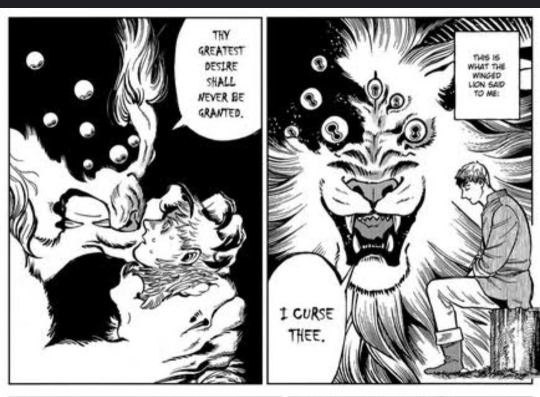
Firstly I want to acknowledge that Laios is still or some what is still the ultimate monster. Whatever he wrote down in his book describing the ultimate monster abilities (not physical appearances I'm focusing on) came true in one way, shape and form. Firstly, the ability to consume the lions desire in the first place. Secondly, in the side stories his poop actually creates a forest. Now the quote "can change shape" actually occurs twice throughout the series (so far).
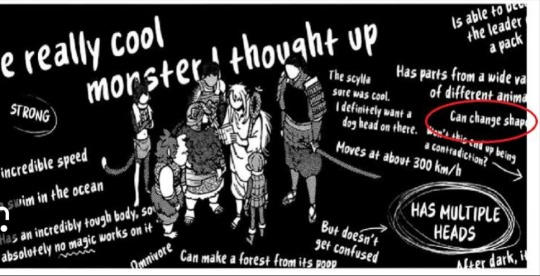
Firstly turning into the monster and secondary, turning back to a human. The second time was not an act of the Lion as said quote "no magic works on it", thus it is completely Laios doing to shape shift freely. It's also interesting to note that both times he sheds his skin when changing into a new form. Like why this specially? Funny enough we do see this other time, as he turns into a wolf in his dreams to save his friend from the nightmares.


Furthermore, while turning back into a tall man, he isn't completely monster free. His aura remains that other monsters still recognize and therefore fear him.
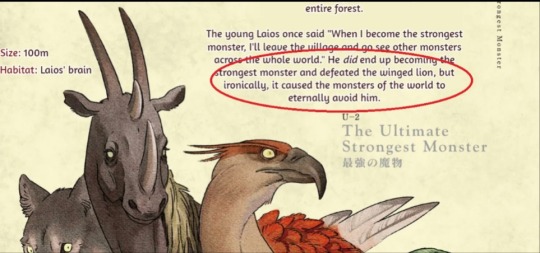

The idea that weaker monsters fear stronger monsters to the extent of avoiding them is mentioned many times throughout the series. For example Senshi talks about how delicate the food chain is and that a stronger monster (squid/ krachen one) caused an imbalance to the abundance of other species. Naturally dragons are known to be one of the strongest monsters in the dungeon, as Thistle set a variety of different species to kill his party. Yet a common thing arises, coexist is near non-existent as power overall dominates all (either by kicking others off their territory or eating the weaker one). This Laios presence being the ultimate monster is not only removing other strong-ish monsters but disrupting the overall food chain.

Now that I establish what I think Laios is I want to drive it back to what his ultimate desire was. Here are some common ideas that I've seen from others on what his curse was:
To never turn back into the ultimate monster again.
Laios has repeatedly mentioned that he wanted to be another race and fauns over Falins chimera form. So never being able to shape shift again could be his curse.
Never will be full.
This theory stems from when Laios is still eating the dragon despite his friends being full/stick from overeating. They make a comment of concern when Laios says he's not really full yet. There is also speculation from one of the panel of Laios being dramatic as he tried to eat a walking mushroom.

Monsters fearing him and/or fail to cultivate them
In my opinion all of these are correct. Yet how?
Laios cannot eat monsters anymore
It was the main driver/theme thought the series from him and his group to eat monsters to survive. Yet little by little Laios ambitious desire to eat monsters for survival quickly became for the pleasure of taste. This isn't a bad thing, as I would like to clarify. Yet the Winged Lion doesn't really have a grasp of humanity and sees desire as desire, thus is exploiting Laios to go down a gluttonous path. And it does this by offering/guide them to a variety of monsters and access to water and basic needs for cooking. This though doesn't work as Laios is Laios. He isn't selfish. His desires for monsters mixed with the need for acceptance is heavily stated with wanted to integrate and cultivate monsters up on the surface. Furthermore, as he's not alone unlike other dungeon masters such as Thistle or Mithrun, his actions are quickly dispelled if they are reckless. For instance Senshi makes a very important note of keeping the ecosystem in balance and to not over take/kill species as it would upset the food chain. Without his party, gluttony would further be his downfall.
Yet becoming the ultimate monster can also be seen as a gluttonous ideal. He's a apex predator, thus like an actual apex predator no one is able to challenge him / prevent him on what he can or cannot eat eat. The only downfall to his survival is his abundance of prey. Heck being able to eat the lion's desire also alludes to his power of gluttony too.
So with the curse, wouldn't it be ironic to prevent his desire to eat monsters. Being the ultimate monster is now a double edged sword as prey escapes him. He cannot share his desires for eating monsters amongst his people anymore, thus the quotes or trial and error from the epilogue pages. Even if he gets his hands on a monster he cannot truly enjoy eating it, as it never makes him full, which can be interpreted from the epilogue page as well. One might look at the page and interpret as him getting ill from eating the walking mushroom too.
Basically, Laios, as a monster, cannot be a part of an ecological process such as a food webs. He wanted to be accepted and liked by his peers, now he's rejected by nature. Forced to crave for the taste of monsters flesh but it remains elusive.
Forever unsatisfied
By ones desire
Thanks for coming to my Ted Talk

#dungon meshi#laios dungeon meshi#laios beong laios#dunmeshi laios#laios touden#delicious in dungeon laios#delicious in dungeon#dunmeshi#dungon meshi mithrun#dungon meshi laios#dungon meshi spoilers#spoliers#dungon meshi theory#delicious in dungeon theory#anime and manga#thistle dungeon meshi#senshi#not proofread#dungeon Meshi#dungeon meshi laios#dungeon meshi
180 notes
·
View notes
Text

I feel like this line of dialogue implies that half foots are prey animals as Chilchuck's anxiety and reactiveness goes away. Most prey animals have some form of anxiety. Along with that, half foots also have heightened senses and seem to be hyperaware (like prey animals) compared to the other human species.
So what exactly made the half foots evolve like prey animals?

#half foot#dunmeshi#dungeon meshi theory#dungeon meshi#delicious in dungeon#tall man chilchuck#chilchuk dungeon meshi#chilchuck#chilchuk tims#half foot biology#dnd#prey animal#theory#dungeon meshi spoilers#dwarf laios#half foot marcille
4K notes
·
View notes
Text

is this anything
#art#fanart#delicious in dungeon#dungeon meshi#taskmaster#my tm watching friend and i have a bunch of theories about how that series would go down
7K notes
·
View notes
Text
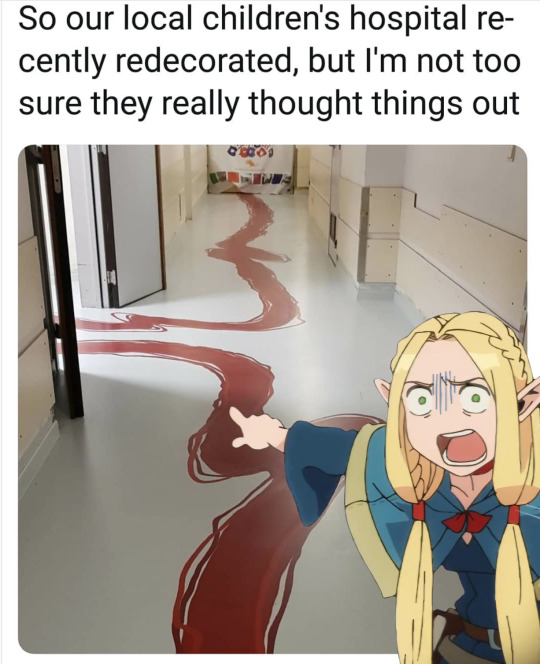
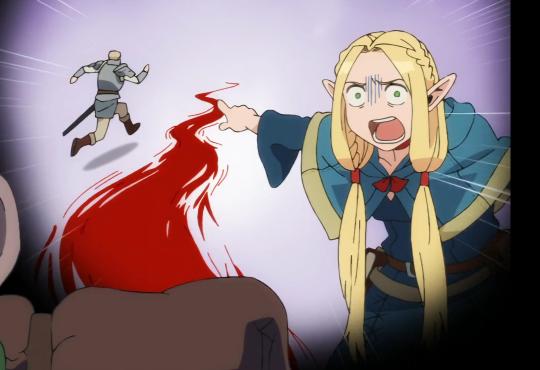
1K notes
·
View notes
Text
Evidence that Kabru from Delicious in Dungeon is Indian, a Masterpost
(EDIT: This post is an excerpt/remix of Kabru's section of my larger essay about the real world linguistic and cultural references Dungeon Meshi. You can read the essay on AO3 here. I also have another post about what part of South Asia I think Utaya is based on here.)
Since Kabru’s first appearance in the anime is upon us, I wanted to write something that compiles all the evidence we have that Kabru is meant to be a person of South or Central Asian ethnicity, or at least whatever the equivalent to that is in the Dungeon Meshi world.
Ryoko Kui can and does draw people of many different ethnicities, and the way she draws Kabru matches the way she draws other Asian characters in Dungeon Meshi. He doesn’t look Black, or Hispanic, or any other ethnicity because he isn’t supposed to. He looks like a dark-skinned South or Central Asian person, because that’s what Ryoko Kui probably intends him to be.
So let’s go through the evidence! (There are no spoilers for the plot of Dungeon Meshi below, but there ARE spoilers for Kabru's backstory as explained in the manga, and in extra materials like the Daydream Hour and Adventurer's Guide book.)
KABRU’S NAME
The Dungeon Meshi Adventurer's Bible tells us Kabru’s real name is unknown. There are other characters whose real names are only told to us in the Adventurer's Bible and were never revealed in the manga, but then Kabru, Thistle and Izutsumi’s entries simply say their real names are unknown, and though Kui could tell us their true names, she doesn’t. I assume this means that the characters themselves don’t know what their real names are, and that the names they go by are not their birth names, but this is only a supposition on my part.
KABRU THE MOUNTAIN
Kabru (काब्रु) is the name of a mountain on the border of Nepal and India, and part of the Himalayan range. It’s the 65th tallest mountain in the world and it is very snowy and icy, with frequent avalanches. Because of this, even though it’s not the tallest mountain in the world, climbing it is challenging, and is not often attempted. Those few that have managed to climb it consider it a major achievement.
“This prohibitively fearful icefall… had thwarted numerous expeditions, perhaps even the 'thought' of attempting the mountain… Unstable seracs of the icefall, a complex maze of chasms, and delicate snow bridges spanning seemingly never ending, near bottomless crevasses… Each time the members stepped into the icefall, they stood a good chance of never returning.” (Kabru - Mountain of the Gods, Major A. Abbey, Himalayan Journal 52, 1996, editor Harish Kapadia)
WHAT DOES KABRU’S NAME MEAN?
Kabru is a character that is known for being very good at charming people, but who doesn’t express himself honestly, because he’s trying to manipulate the people and situations around him in order to maintain control at all times. I think nobody really knows who Kabru is deep inside, maybe not even Kabru himself, so a remote, hostile, icy mountain that’s hard to climb seems like an extremely appropriate name.
Some of the oldest English sources I found regarding Kabru suggest that Kabru isn’t the correct local name for the mountain (a common problem in early Himalayan exploration by Europeans) and might just be a descriptor, or that it’s a misspelling.
This makes the name seem even more appropriate, since Kui’s told us Kabru’s true name is unknown. It’s possible that Kabru was a place-name or a descriptor that Milsiril (Kabru’s elven foster mother) was given when she picked up a traumatized 7 year old Kabru, and she just started using it as his name, and that even he doesn’t remember his real name thanks to his severe trauma.
The fact that people in the real world can’t seem to agree on the mountain Kabru’s name, or what it means, reminds me of the running gag of Laios repeatedly getting Kabru’s name wrong in the manga.
"All the people near the Kabru massif call it 'Kaboor'." (The Alpine Journal, 1921-22 Volume 34, Edited by George Yeld and J. P. Farrar) “It is also said that the name applies to a peak close to Kinchinjunga on the southeast, and not to the peak known to Europeans as Kabru… [The real name is] Pahung Ri [Pauhunri].” (Appendix I: Place Names in Darjeeling. The appendix says it was “compiled mainly from an article written by Colonel Waddell and published in the Journal of the Asiatic Society of Bengal (Vol. LX, part I, 1891)”) “Kangchen is a Tibetan name… the Sikkhimese use it as the name for the peak called Kabru by Europeans.” (Charles Bell, Dyhrenfurth's Himalaya (Berlin, 1931)) “...Kyabru or the horn of protection. The name is… Kabur… possibly a corruption of Kangbur or the swelling of snow; it might also mean the white swelling (kar-bur).” (Appendix I: Place Names in Darjeeling.) “Kabru literally means the 'White Avalanche' peak (Ka means 'white' and bru means 'avalanche').” (Kabru - Mountain of the Gods, Major A. Abbey, Himalayan Journal 52, 1996, editor Harish Kapadia)
I’ve seen one other mountaineering article cite the “white avalanche” meaning, and I think it’s plausible since the Appendix says it can mean “white swelling” or “swelling of snow”, which may very well be a literal translation for “white avalanche”.
WHAT ABOUT UTAYA? IS THAT INDIAN TOO?
Utaya means “raised” or “uplifted” in Hindi, but it’s also a real village and a Japanese boy’s name.
Utaya (ウタヤ) is the name of the village that Kabru was raised in before his mother died and he was adopted by the elf Milsiril. Utaya is located in the southeast of the Western Continent. It’s worth noting that Kabru probably wasn’t born in Utaya, since his mother had to flee from her home to keep Kabru alive, so Utaya may be some distance away from his birth place… Not so far that a woman with a newborn baby couldn’t survive the trip, but far enough that her husband’s family gave up on chasing her. So Kabru was probably born in a close-by area.
In the real world, Utaya (Yakut: Утайа) is in an extremely rural and isolated area with a population of less than a hundred people. It’s located in the Sakha Republic, which is in the Northeastern part of Asia in the Russian Federation. The Yakut/Sakha are a Siberian Turkic people.
The Turkic peoples are a collection of diverse ethnic groups of West, Central, East, and North Asia as well as parts of Europe, who speak Turkic languages.
Early and medieval Turkic groups exhibited a wide range of both East Asian and West-Eurasian physical appearances and genetic origins, in part through long-term contact with neighboring peoples such as Iranian, Mongolic, Tocharian, Uralic/Yeniseian peoples, and others. Turkic peoples share, to varying degrees, non-linguistic characteristics like cultural traits, ancestry from a common gene pool, and historical experiences.
JAPANESE MEANINGS FOR UTAYA
Utaya can be a Japanese boy’s name with several different meanings, depending on which kanji it’s spelled with. In most of the spellings: Poetry, sing a poem, singing, compose poetry
In many of the spellings: The place where the sun shines, it's been a long time, distant, big, to shoot with a bow, to swear, affirmation, question.
The Utaya disaster happened a long time ago.
If Utaya is up in the mountains above the clouds it’s a place where the sun shines brightly.
Kabru has sworn to himself that he will prevent another Utaya tragedy from happening.
In only a few of the spellings: to mend, feathers, wings, a word for counting birds and rabbits, sort them out, washing with water to separate the good from the bad, roof, house with a roof, a world covered with a big sky, infinite space, song that praises the Buddha, Eight.
Counting birds and rabbits makes me think of divination and also that the people of Utaya were like little birds and rabbits (small prey animals) to the monsters that devoured them.
Separating the good and the bad could hint to the “judgment” of Utaya and the greed of its people that led to their downfall, also sorting through things to separate good and bad is something that’s done with food and other resources.
The Himalayan region is often referred to as the “roof of the world”, with a big open sky above it.
The infinite could refer to the dimension the demon comes from, or to the sky above the mountains.
Buddhism is a common religion in the Himalayan region, and eight has auspicious connotations in Buddhism.
With all that in mind, Utaya as a name for Kabru’s home village is an interesting choice, and adds another layer to his origins, maybe suggesting not just North Indian/Himalayan, but Central or North Asian cultural influence as well.
It is also possible that the name is just telling us that Utaya is “up” in the mountains, or that it was “uplifted” by the wealth of the dungeon, or even that Kabru was “raised” there… The Japanese name meanings are also extremely fascinating and hint at similar ideas, as well as the tragedy that happened to Utaya.
WHY ELSE DO YOU THINK KABRU AND UTAYA ARE HIMALAYAN?
In the real world, the Himalayan mountain range is an extremely popular tourist destination, and the amount of people who want to visit and attempt to climb the mountains far outpaces the local ability to support it. This makes me think of the dungeon of Utaya and how people overcrowded it in their desire to conquer and exploit it.
Dungeons as an unsustainable way for locals to make a living that leads to the destruction of their homes when the dungeon inevitably collapses is a major plot point in Dungeon Meshi, so I think the parallel is likely intentional. Characters often talk about someone “conquering” the dungeon, and “conquer” is also the terminology commonly used for climbing a mountain. This terminology obviously has a hostile, imperialist subtext in the real world, since it’s most commonly used by outsiders talking about proving their strength by climbing a mountain.
Also, there are local legends in the areas surrounding Mt. Kabru that there is a valley of immortality hidden on its slopes, which reminds me of the way that the dungeons can grant conditional immortality to the people inside of them.
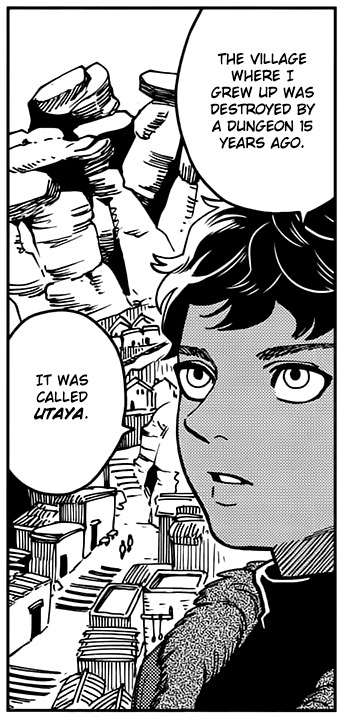
This image of Utaya could be showing us a village built on a mountainside. The house shapes seem a bit more Middle Eastern than Nepali/Indian, but it’s not a detailed drawing and the roof styles are a mix of flat and peaked.
CULTURE
In the Daydream Hour sketchbook, Ryoko Kui included a small comic about characters sharing desserts from their home countries. A young Kabru is shown enthusiastically trying to share an unnamed sweet, and he is interrupted by his elven foster mother, who insists he present a type of elven cake instead. We know that Kabru hates this type of cake, and he seems disappointed to have to eat it and talk about it.
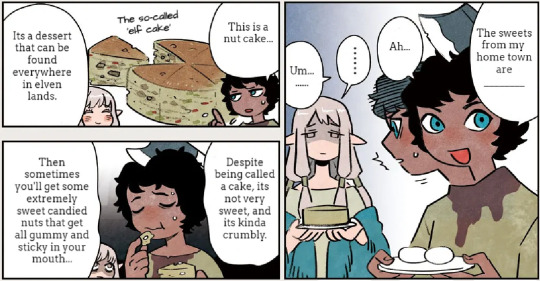
The white balls in Kabru’s dessert are very likely meant to be an Indian sweet called rasgulla (literally "syrup filled ball"). Rasgulla are a dessert popular in the eastern part of South Asia, made from ball-shaped dumplings of chhena dough, cooked in light sugar syrup. While it is near-universally agreed upon that the dessert originated in the eastern Indian subcontinent, the exact origin is disputed. Rasgulla are as culturally important to the Bengal and Odisha regions of India as Parmesan cheese is to the region of Parma in Italy.
Rasgulla are also popular in Nepal, where they are called rasbari.
KABRU’S PHYSICAL APPEARANCE

Kabru is one of several characters in Dungeon Meshi with clearly non-European features: he has brown skin and thick black/dark brown curly hair. He has almond-shaped eyes with long, dark lashes (fans like to joke that he’s wearing eyeliner). All of these are traits common to people from the Indian subcontinent. His blue eyes are not common for someone with his skin/hair color, but blue or green eyes are not unheard of in that region either.

(Indian man with blue eyes)
Blue or light eyes are often a cause for discrimination, like what Kabru experienced as a child. More on this in a moment.
Kabru is 5’7” (170cm) tall, which is short for a Northern European man (180), tall for a Nepali man (162cm), but close to the average height of Indian men (177cm). He has a slender build, which is also common for Asian people in general, and South Asian men in particular.

Compared to the European-looking tall-men in Dungeon Meshi (such as Laios, Falin, Delgal, Marcille’s father), Kabru’s facial features look more like the other Asian characters, such as Toshiro and his party.
CAN DARK-SKINNED PEOPLE HAVE BLUE EYES?
Yes. Light-colored eyes are very uncommon in parts of the world where most people have dark eyes, since dark eyes are a dominant trait in real-world human beings. That means that in order for two parents with dark eyes to have a child with light eyes, both parents need to have a recessive light-eyes gene (or for there to be an illness or genetic mutation), and that’s rare in populations that don’t have a lot of light-eyed people to begin with.
THEN WHY DO SO MANY DARK-SKINNED CHARACTERS HAVE BLUE EYES?
Anime and manga often give characters with dark skin light colored eyes instead of allowing them to have brown or black eyes, which is much more common in real life. It’s a hurtful design trope that makes many readers feel that their natural dark eyes are somehow ugly or inferior to blue eyes.
This trope is used over and over again by authors who want their characters to look “cool” and “exotic”, and for their eyes to be high-contrast to make it easier to show their emotions.
I don’t think this is what Ryoko Kui is doing in Dungeon Meshi.
UNREALISTIC HAIR AND EYE COLOR COMBOS IN ANIME
In a lot of anime/manga, blue eyes (regardless of skin color) don’t actually mean anything in the narrative, in the same way characters having green or pink hair doesn’t mean anything, the colors are non-diegetic, they don’t actually exist in the world, like the music that plays in the background without an on-screen source.
It’s an artistic shorthand to make characters visually stand out, instead of giving them all black hair and eyes like most real-life Japanese people… Which is what most anime/manga characters are meant to be: Japanese people.
Dungeon Meshi has a large cast of characters that are explicitly meant to be non-Japanese. We know this because there’s a group of characters that are Japanese, and they’re drawn differently from everyone else, they wear ethnically Japanese clothing, and have ethnically Japanese names.
Unlike other series, where eye and hair color don’t mean anything, Dungeon Meshi has no unrealistic skin, hair, or eye color combinations.
(Except for the elves, who seem to have different genetics than real world-humans. I’ll get into that another time.)
Ryoko Kui must be aware of the dark skin, blue-eyes design trope, because if she gave Kabru blue eyes just because she thought it looked good, surely she would have made some of the other Asian or dark-skinned characters have light eyes. Out of 9 Asian or dark-skinned tall-man characters, Kabru is the only one with blue eyes.
Kabru having light-colored eyes is central to his story, and Kui talks about it.
KABRU’S STORY AND WHY HIS BLUE EYES MATTER
Kabru’s father and his family tried to kill Kabru when he was born because he had blue eyes. Kabru’s mother ran away, and ended up raising Kabru by herself in Utaya. She didn’t try to return home to her own birth family, but instead struggled to raise a child completely on her own with no money or support, which implies she had no other options, due to the fear people of their region have for people with blue eyes.
This is a real thing that used to happen frequently in areas where most of the population has dark eyes, and it still happens to this day.
In a realistic story, this is logically what would happen to a character with dark skin born with blue eyes in a place like the Utaya region. It’s rare for manga or anime to show dark-skinned blue-eyed characters facing this.
WHAT IS THE “EVIL EYE”?
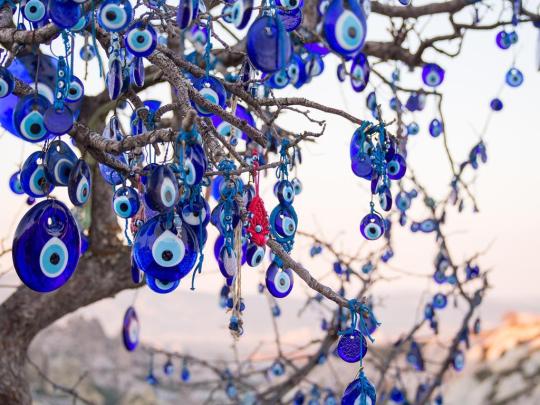
The “evil eye” is a supernatural belief in a curse brought about by a person looking at you. The belief in the evil eye has existed since prehistory, as long as 5,000 years ago. It is estimated that around 40% of the modern world's population believes in the evil eye. This concept is most common across the Mediterranean, the Balkans, the Middle East, and Central and South Asia, areas where light-colored eyes are uncommon.
In areas where light-colored eyes are rare, people with green eyes, and especially blue eyes, are thought to bestow the curse, intentionally or unintentionally. Just one look from a blue-eyed person is often considered enough to inflict a curse.
One of the most famous and widespread talismans against the evil eye is the nazar, a glass amulet featuring concentric circles in dark blue, white, light blue and black. It’s supposed to “bounce” the curse away from the wearer.
HOW DOES THIS APPLY TO KABRU?
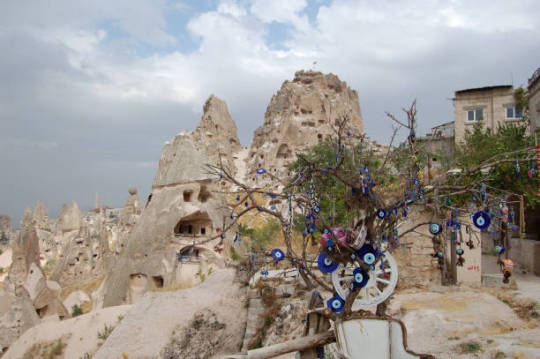
Imagine Kabru growing up in a village surrounded by people wearing and hanging talismans that look like his eyes, because the people around him think blue eyes are evil. They call his mother a witch for birthing him, and a whore because she doesn’t have a husband. Imagine parents forbidding their children from playing with or even talking to Kabru. People crossing the street to get away from him, or chasing him away by throwing rocks.
I think the reason young Kabru was able to learn how to speak some kobold is likely because he was so heavily ostracized by the other tall-men around him, the only children he could occasionally interact with in Utaya were kobolds, who might not share the same cultural superstitions that the tall-man do.
This childhood trauma, combined with Kabru’s experience of the dungeon collapse in Utaya, and being raised by an elf that treated him more like a pet than a human being, set Kabru up as a character who has never had a home where he belongs. He has been an outsider from the instant he was born, and every place he has lived treats him as an “other.”
To his father’s family, he was a curse. To his mother, although she loved him, he was a burden. To the people of Utaya, he was a monster. To the elves, he’s a tall-man baby (no matter how old he gets) with funny looking eyes, to the people on Merini Island, he’s a foreigner from the West with elven ways and education.
CONCLUSION
I wanted to write this because I know some people will see Kabru in the anime for the first time today and think "Oh, another dark skinned blue eyed character! This is a bad character design that is evidence that the author is racist at worst or ignorant at best.” And I don’t think that’s a fair assessment of Ryoko Kui’s work in Dungeon Meshi.
This isn’t to say that Ryoko Kui has never done anything wrong, or that her work couldn’t be more inclusive, or that there’s no way in which she could improve.
But there are pages and pages of artwork she’s done that shows she cares about these issues, and I think it’s worth celebrating when someone makes that kind of effort with their artwork.
ANYWAY…
If you’ve read this far, you’re very strong hahaha. I hope you enjoyed this essay. I’ll be publishing more soon when I finish my Dungeon Meshi research on the names and cultures of all the characters. Wish me luck!
#dungeon meshi#delicious in dungeon#dunmeshi#kabru#my stuff#analysis#character of color#theories#Dungeon Meshi Research
2K notes
·
View notes
Text
Rin, smiling, and nagging

Rinsha Fana’s character is summarized in a couple facts thrown here and there. Because she worries for him, she follows Kabru to help his cause and protect him, and to nag him. She’s a grumpy angry tsundere, but it seems not only rooted in her attitude but on a deep rooted physical level, to the point where any intense emotion she feels will make her frown and scowl even if it’s genuine joy. Her childhood was half spent ostracized in the tallman community her family lived in and half with the elves, where she’s said to have been treated like an animal.
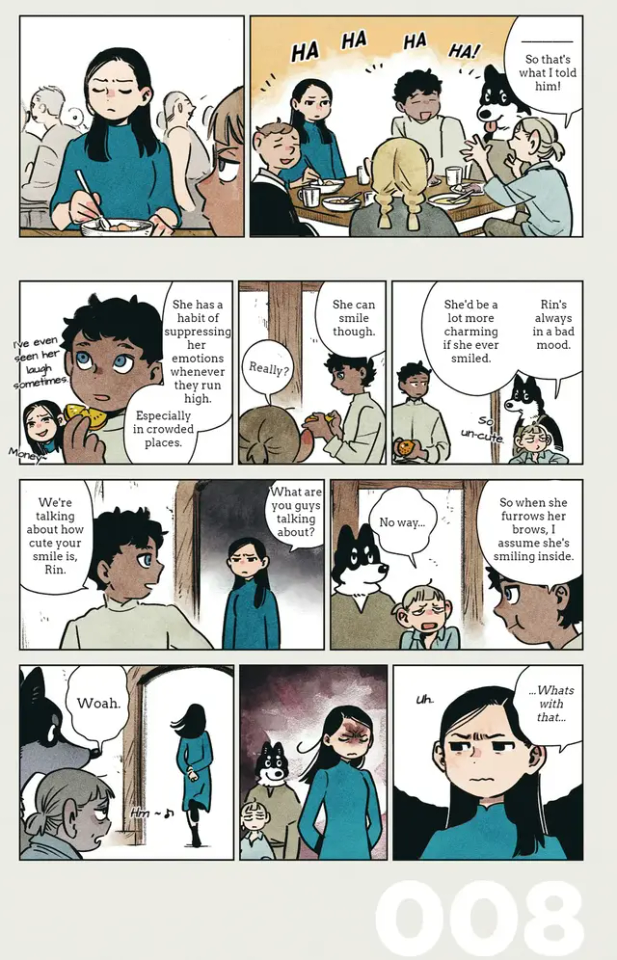

We don’t know how she was raised exactly or who it even was, but knowing she was "treated like an animal" by the elves taking care of her…
Elves are shown to have a highly hierarchical society, not only with their concern with status such as nobility and the purity of bloodlines but also reflected by its social culture imo. They have high society and etiquette, upmost devotion to the queen, very role-oriented, like cogs in a machine, and as such, it’s a bit skewed since most of what we see of the elves is in a military context with military people but they seem to value having emotions under lock and key to be efficient and not bring dishonor, Flamela is an interesting character on this. Don’t be a bother and do your job until you’re called on, fulfill your role, everything else is extra at best inconvenient at worst.
Personally I do think the canaries kept Rin, it’d make sense that whichever canaries got stuck with the job at the headquarters would be barebones with her and treat her like an ‘impounded article’, they couldn’t find another place for her and this way they can get her report on the events whenever she can speak again in however many years, and this way it makes sense that she could keep in touch with Kabru too. They’re used to prisoners, not kids. Being raised in a military context rather than at some orphanage would shape her further.
All of this to say…


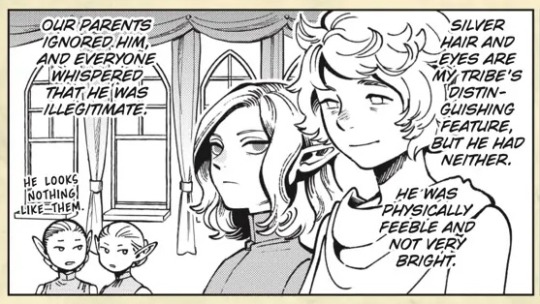

She’d already seen the world’s harshness to those who don’t conform in her hometown, but with the elves? Her disdain for those who had formal education at a magic school?
Wouldn’t she become very concerned with proving she is not an animal, proving that she’s smart and skilled in her own right on her own merit, even without schooling. And to do this she nitpicks and nitpicks, because even being pristine isn’t enough to be respected, but at least it’s not giving others reasons to disrespect and dehumanize her. Learning to school her emotions, to scowl as a defense mechanism because anything else makes her vulnerable, because they don’t care about her as a person with feelings, because showing other expressions was dangerous or punished in some way: because it was fit in or don’t fit in and that’s the difference between having your house burnt down and being tolerated, between getting her food or having her questions answered and being yelled at to shut up… Because all her life she’s been surviving in hostile social environments and at the mercy of others, but unlike Kabru she doesn’t become a people pleaser but becomes very self-reliant and wary of socializing.
So she nitpicks and nitpicks and nags, because she’s worried. Because flaws are dangerous. So she has a hard time smiling and laughing, because it’s dangerous to allow yourself to feel safe in being authentic.

It would be nice…


Is my red, red enough? I'm waiting for your teeth at my throat. It’s only good manners. -Stephanie Valente
#Dungeon meshi#delicious in dungeon#rinsha fana#rin dunmeshi#character analysis#Kabru and rin have many parallels where they kinda take opposite routes on the same problem#Rinsha fans how are we feeling#Theory/speculation#Overcompensation i love you……… god she’s such a survivor. The refugee trauma i 😭#Is my red red enough is her blood human enough i’m gonna walk into the ocean#Wether or not her nagging actually promotes upstanding demeanor is another topic but I do think this is why she DEFAULTS to nag n scold#I don’t think she’s self-aware about her thinking like this. It’s all just the obvious way to be for her
567 notes
·
View notes
Text
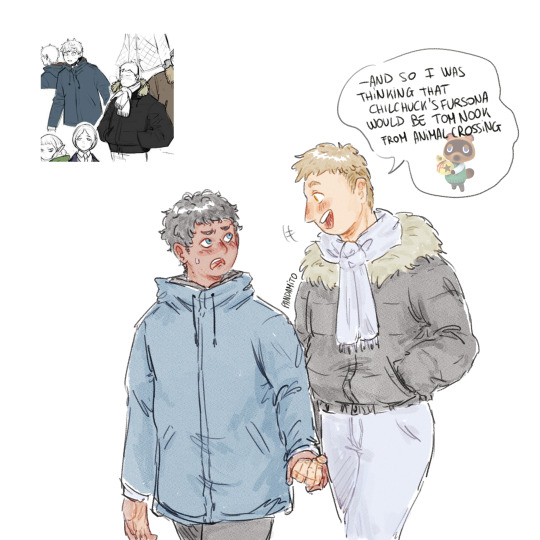
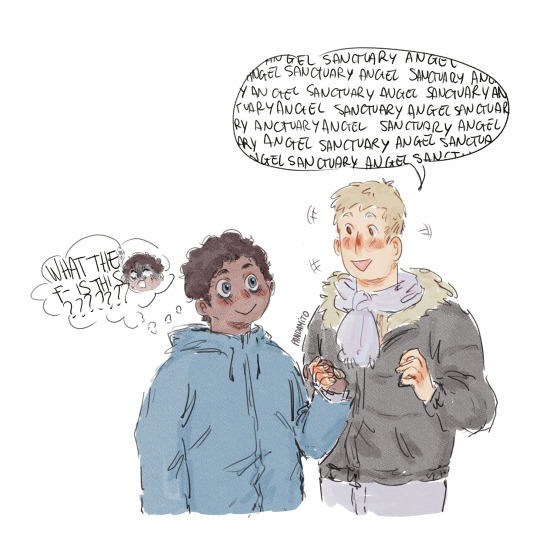
i saw those ryoko kui's sketches and i had to draw laios and kabru
#please read angel sanctuary#dungeon meshi#dunmeshi#dungeon food#delicious in dungeon#laios touden#kabru#kabru of utaya#kabru dungeon meshi#kabru dunmeshi#laios dungeon meshi#dunmeshi laios#laios x kabru#kabru x laios#labru#my art#pandamito#support my chilchuck is tom nook theory
1K notes
·
View notes
Text

[Dun meshi manga spoilers!] do you guys ever think about how Thistle is the perfect parallel and amalgamation of every major character in dun meshi. Everything he did was to protect his brother, his best friend, just like how Laios went to all these extreme lengths to save Falin. However, he lost himself to the better of his fears and to the madness of the dungeon/lion, just like Marcille. Senshi watched his family die, helpless to do anything and Thistle, who spent all of his upbringing, serving Freinag, could do nothing when he suddenly died. Chilchuck has a strained relationship with his family because he lacked emotional availability, and Thistle’s family relationship was ruined because of his lack of emotional control. Izutsumi grew up without a family until the others, and as far as we know, Thistle probably grew up in a similar situation as to her before being taken into the kingdom. I believe this to be true considering he was literally just brought in one day as a bought servant, so he was probably in some kind of similar trafficking situation to Izutsumi beforehand. I 🩵🩵🩵 Thistle guys
#thistle#dungeon meshi#delicious in dungeon#thistle dungeon meshi#thistle dunmeshi#laios touden#falin touden#marcille donato#senshi dungeon meshi#senshi of izganda#chilchuck#izutsumi#thistle makes me cry#my beautiful son#HE’S A CHILD NOT A TWINK YOU PERVS#anime#theory#analysis#crying at the club
230 notes
·
View notes
Text








🔥🎬2024 has been giving us some amazing animated shows!🎬🔥
#x men 97#delicious in dungeon#jentry chau vs the underworld#fop a new wish#rock paper scissors#invincible fight girl#they're so good#Sorry if I missed any shows!#definitely recommend#Haven't seen invincible fight girl yet!#But I heard it's good.#I'm only counting shows that came out this year#nick rps#dungeon meshi#jcvtu#jurassic world chaos theory#jwct#Animated shows#tales of the tmnt#tales of the teenage mutant ninja turtles
165 notes
·
View notes
Text
On the downside of the ep. 10 of Dungeon Meshi dub having Chilchuck say "You're so cringe!" is that it isn't actually what he said in the original manga. It was more akin to "You couldn't have picked a worse time to say that!"
On the upside, we have a voice clip of Chilchuck saying "You're so cringe!"
#dungeon meshi#delicious in dungeon#chilchuck#my theory is that the original japanese was too short for the dubbers to translate it correctly#still could have done better though
850 notes
·
View notes
Note
i know that this has probably never been discussed in twisted wonderland before, but im curious to know what you'd think about whether necromancy would be considered a taboo/"dark" magic (like in dungeon meshi, if you've watched or read it)?

I read like one volume of the Dungeon Meshi manga a few years back :DD but unfortunately never read (or watched) beyond that! I don’t think that background knowledge is needed to talk about necromancy though, it’s a relatively common thing in fantasy or magical worlds.
I’m thinking that necromancy either doesn’t exist (since we’ve never heard of any reference being made to it) OR that it does exist, though it is probably taboo and it must either be a forgotten art, or very extremely difficult to achieve. This is because Malleus is one of the top 5 strongest mages in Twisted Wonderland (and his grandmother is described to be even more powerful than him) yet he does not indicate he has the capacity for resurrecting the dead??? Even though you’d think that if necromancy was possible, the Draconias would be capable of it and Maleficia would want to revive her only child, regardless of the ethics of it (which would be dicey). Furthermore, Malleus and others in the cast (like Idia, Rollo, etc.) seem to act as though death is finality. When Lilia shares that his magic is waning and that he is going to retire to (and die in) the Land of Crimson Long, Malleus laments that, despite all his magical power, he cannot stop the hands of time. If magic could solve everything, then Malleus would casually pull that necromancy spell out of his ass, no??? In Idia's case, the researchers from S.T.Y.X. react with revulsion when Idia constructs an artificial intelligence modelled after his deceased younger brother. This makes it seem like to "bring back the dead" is considered forbidden.
I want to add that ghosts don’t count as the result of necromancy; in-universe, we get the lore that ghosts are the dead who were not able to pass on due to an strong earthly desire or unfulfilled wish keeping them chained to the land of the living. Ghosts also tend to only be seen in areas with high magical energy, like NRC campus. They also have abilities and limitations which are not the same as fully restoring someone from the dead. I’m not sure what the senators count as (since they’re not described as ghosts), but I don’t think they count as instances of necromancy either.
There’s a fan theory that Crowley is Malleus’s missing father Raverne—however, a certain variation of that theory elaborates that, if true, it recontextualizes the speech Crowley gives at the start of the game. Some speculate that the “flower of evil” he speaks highly of is his dead wife Maleanor. They suggest that Crowley is someone purposefully orchestrating OBs (an idea proposed by Idia in book 6) to gather blot stones (Crowley does ask us in the main story if we’ve seen blot stones lying around) for use in a ceremony to revive her. That’s just a theory though! There’s an alternative theory that Crowley is trying to revive the Great Seven as well. As I said before, we have yet to receive any official confirmation that necromancy is even possible in Twst.
#twisted wonderland#twst#disney twisted wonderland#disney twst#Dungeon Meshi#Delicious in Dungeon#notes from the writing raven#question#book 7 spoilers#book 6 spoilers#Idia Shroud#Lilia Vanrouge#Malleus Draconia#Maleficia Draconia#Maleanor Draconia#Dire Crowley#Raverne Draconia#twst theory#twst theories#twisted wonderland theory#twisted wonderland theories#Ortho Shroud#Ignihyde#Rollo Flamme
100 notes
·
View notes
Text
World Map Notes: the Elven Northern & Southern Central Continents
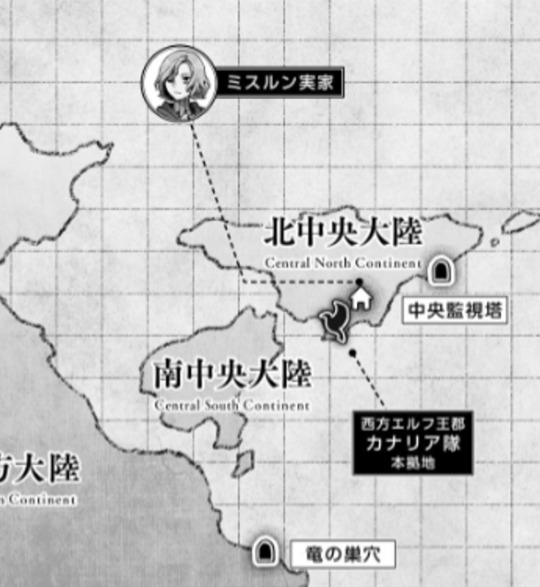
These nations are where all the elves in the story except Marcille and Thistle are from. This post collects all the information I could find about these two nations, and included a bit of analysis based on that information.
TL;DR (includes both fact and my speculation):
The Northern Central Continent is a feudal monarchy with a strong class system, as well as strict borders, & could probably be considered an ethnostate. It's deeply hierarchical, and the queen is a traditionalist - so it's probably very structurally biased against non-elves and half-elves.
Elves in the NCC practice cannibalism in some rural areas!
The Southern Central Continent is more diverse, with a large tallman population on its South Coast.
To elves, "Court Magicians" exclusively refer to those serving the elven queen - a prestigious role that seems likely to be only open to nobles.
The SCC may not be a monarchy, though it's not clear what kind of leadership or societal structure it does have.
The NCC will habitually take anyone involved in ancient magic as a criminal to prosecute on their terms, regardless of jurisdiction, but this depends on their political influence and ability to pressure local leaders to agree to extradite the criminal.
Elves VS Dwarves and Gnomes may have been at war around the time of the Golden Kingdom being sealed. This conflict also may be one of the factors pushing the kingdom to be sealed in the first place.
The "Central Region" might be the origin of the "Common Tongue" that our characters speak.
Northern Central Continent
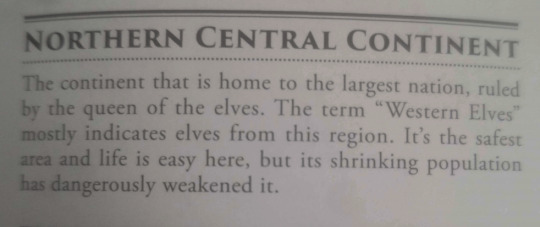
The Adventurer's Bible | p. 132
For this place to have a high quality of life, and also a declining population - especially when it's so close to the Western Continent, which is stated to have poor quality of life - there must be strictly maintained borders and a strong anti-immigration policy. Based on the attitude of the elves, I wouldn't be surprised if it was very difficult to move there unless you are also an elf.
It could probably be considered an ethnostate - and while in these kinds of fantasy worlds, that's pretty common. Take Rivendell, or Moria, in LOTR - they take for granted that these kinds of different fantasy races will live in separate communities.
But that isn't actually realistic, and I think Kui has considered it as more of a politically established status quo rather than an obvious natural result of having magically distinct "races". Which, even in Dunmeshi, I think is a difficult and not-terribly-accurate way to represent politics - racism does not emerge from actual, physical differences between races, after all.
But Dunmeshi's presentation of this idea is interesting, because of the recognition that if there is an "elven nation" which prioritises the interests and rights of elves over other races, that is because there's a deliberate, concerted effort to keep it that way.
But there's a small section of the NCC with a high tallman population - I wonder what kind of community they have, and how they fit into the strict elven hierarchy?


The Adventurer's Bible | pp. 134 & 136
Kabru and Rin, and other kids like them, who are adopted or taken as adopted children(rarely - the way Milsiril treats Kabru is not perfect, but she's deliberately attempting to be better than other elves.... meaning other elves are usually worse)/pets/objects by elven nobles, as well as accomplished or notable individuals who earn the elves' favour/are "invited" to stay (such as they try with Laios at the end of the story) would be an exception.
Other long-lived races could probably (...?) visit, but given the historical conflict between elves, dwarves, and gnomes, I think they'd also be pretty hostile to many of them coming to live on the NCC, even if they see them as more like equals.
Social Structure & Nobility
The Northern Central Continent is an absolute monarchy under a 372 year old queen, Heimeya (IDK what the official romanisation of her name will be).
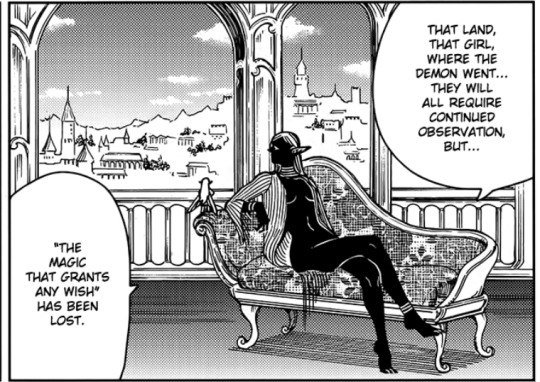
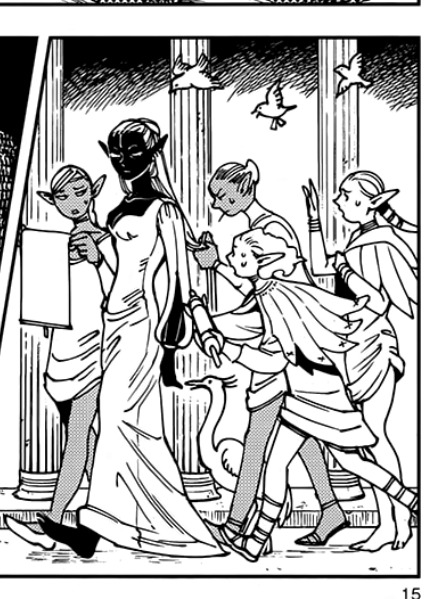
...With extended "nobility", which are the group that the canaries' guards draw from. We don't get much clarification of what sort of structure their nobility has, what titles there are, and where our characters who are nobles fall into it.
Pattadol (House of Vari), Mithrun (House of Kerensil), and Milsiril (House of Tol) are nobles.
Mithrun's noble house, Kerensil, is apparently a well-known family of investors! I wonder what sorts of businesses they invest in & what the elven economy is like?
Milsiril's house, on the other hand, is a well-known military family. I wonder if Kabru could claim the surname "of the House of Tol". He did go to family gatherings after all. But if he was comfortable doing so and it would be accepted, I would assume he'd have done so when introducing himself to the canaries.
Flamela is a distant relative of the queen, who has additional status due to exhibiting the genetic trait associated with their queens, extremely dark skin.
The queen is a "staunch traditionalist" who wouldn't even acknowledge a half-elf like Marcille. Nice! I really feel bad for Kabru and Rin growing up as tallmen in this sort of culture.
Court Magicians
While generally this is a term for any magic user who serves in a royal court, in the Northern Central Continent it seems to carry a lot of esteem; even just as the daughter of one, Pattadol assumes Marcille has the right to boss her around and to handle highly secret, highly illegal ancient magic secrets.
That makes sense, as in the society of the Northern Central Continent, you'd be directly serving the elven queen. But also, she has enough Court Magicians that Pattadol would not expect to know Marcille's mother's name, but few enough that it would be a big deal and Cithis would know about it if one had a half-elf child.
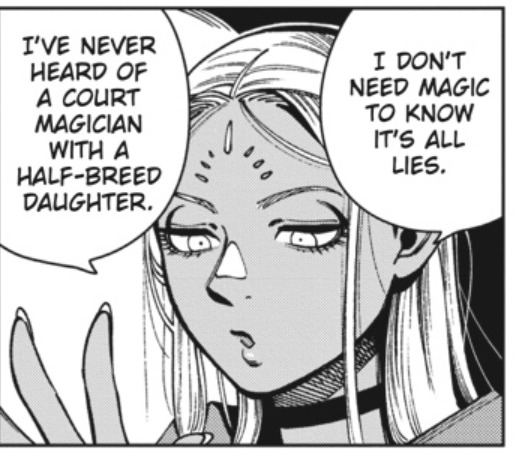
I don't think it's remotely unlikely based on that to assume that this role is only available to nobles.
A "Court Magician" who doesn't serve the NCC Queen isn't a "real" Court Magician in the eyes of NCC elves. Those short-lived monarchs would be happy just to have an elf around regardless of whether they were actually any good at magic.... according to Cithis.
Magic seems very important to the society of the NCC elves. The queen communicates with her subordinates via familar, and the birds we see surrounding her seem like they are some kind of magic - perhaps not familiars since we see her familiar, but some other kind of scrying?
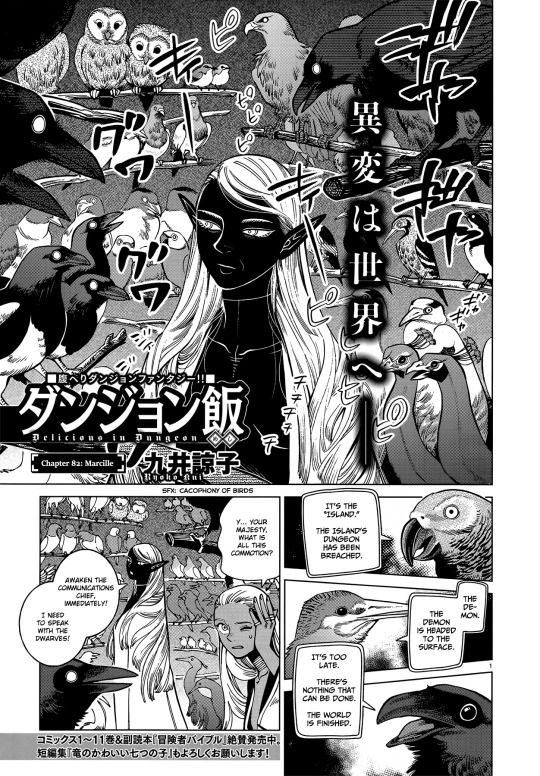
Also, based on the fact Pattadol assumes a Court Magician would be serving the Queen of the NCC, we can theorise that perhaps whatever structure the SCC has, it isn't a monarchy....? Heimeya is "the queen of the elves", after all - that doesn't sound like there's another elven monarch competing for the title just next door.
Ordinary People
Apparently the NCC is a safe place and life is easy -- but given the strict class system, I kind of expect that varies a lot depending on the family you're born into.
The only elves we meet who are not nobles are the convicted criminal canaries, so it's hard to get a sense of what life is like for them from that. Cithis was apparently a wealthy fortune teller with "an intense jealousy for those born noble or wealthy." So I assume she was not born into comfort.
Apparently "There are also primitive villages deep in the woods and underground, and in some regions cannibalism is still practiced." Which is awesome. Based on her videogame elves art I think Kui's probably making a little nod to Divinity: Original Sin elves, who can absorb memories through eating the flesh of others. Elves in dungeon meshi don't have this trait, but I wonder if there is a magical ritual or some kind of cultural practice with a similar intention.
Cuisine
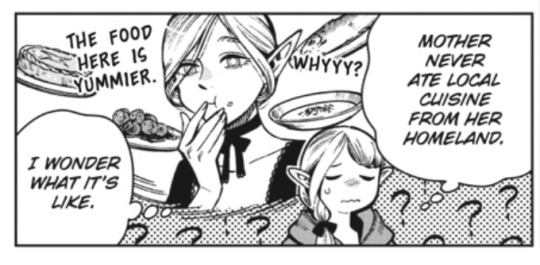
Marcille's mother didn't think much of the elven cuisine.
Liricmumwarel is fancy candy given out by the elven queen the shape of which conveys blessings.
Elf Cake is a crumbly dry cake that Kabru and Thistle don't think much of. I've heard someone discuss what it's likely to be made of, but I am afraid I don't recall.
Southern Central Continent
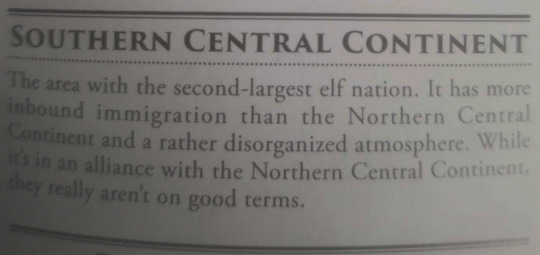
The Adventurer's Bible | p. 132
It seems like the Southern Central Continent gets a lot more immigration and has a more diverse population, especially along the south coast (near the Western Continent). That south coast has a high tallman population.
Fleki and Lycion are from the Southern Central Continent. Fleki got into ancient magic for the money, so you can assume there's probably class disparity there too; things are noted by Kui to be more "disorganised" than the NCC. Not a bad thing at all - the NCC is definitely too "organised" in my books. But that does potentially also mean there's less, e.g., bureaucracy, central organisation, less of a social safety net. But then again, in the NCC I doubt that whatever "safety net" there is, is available to everyone.
We can't extrapolate much from Fleki & Lycion's personalities, because they clearly aren't in the most stable societal position, and I get the sense that they're the countercultural type - they probably don't represent the type of person typical to the SCC. Also, our NCC characters are all either nobles or used to navigating high society (Cithis, Kabru to an extent) so they aren't exactly a typical "ordinary NCC person" as a basis for comparison either. However, there's less of a "strict set of social rules" type of feel to the SCC characters, fitting with my suggestion that the SCC may not be a society with a strong feudal element.
Geopolitics & Conflict
The fact that, despite their being from the SCC, Fleki and Lycion are in the Canaries, who work directly under the NCC's Queen, implies that the the NCC feel entitled to process and prosecute people who commit ancient magic-related crimes regardless of any notion of "jurisdiction". This is backed up by the way that they were going to take Marcille - but that is something that the governor of the Island had to give permission for, which Laios is able to withdraw. So I assume that the NCC elves apply pressure on various world leaders to extradite criminals involved in ancient magic.
The SCC would cooperate with this, since they're allies, even if they don't have a great relationship (according to the World Guide).
The NCC are also clearly able to take half-foots without trouble, as we see by Chilchuck saying he's known half-foots who got involved with "black magic" (ancient magic) and were disappeared by the elves. But I doubt gnomes or dwarves are giving people up easily - though that probably doesn't go for dwarves like Senshi and Namari, without strong community ties.
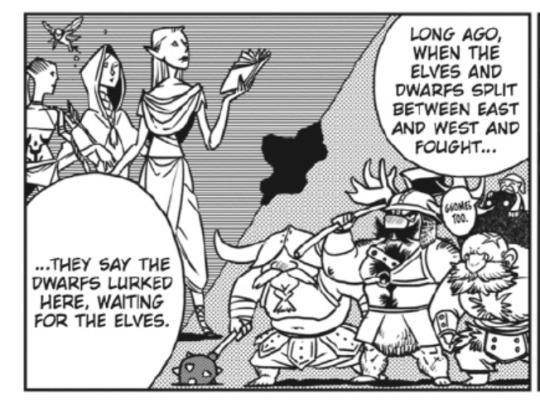
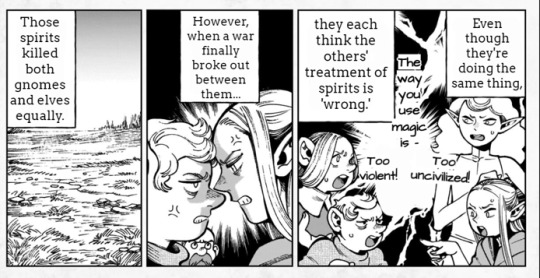
Long before the current times, elves fought dwarves & gnomes. There might have been more than one of these conflicts...? While long ago, this war isn't "ancient" (like the ancients who sealed the demon into dungeons, before their world was mostly destroyed by it).
Thistle, Delgal, and the Golden Kingdom were (I believe) caught up in one of these conflicts, which used Melini as a staging ground - thus why Thistle was pushed to seal the entire kingdom in the dungeon.
To do this, Thistle unseals a dungeon created by the "ancient people". These could be the "ancients" who created the dungeons, before the apocalypse. Or they could be another, still extinct, society.
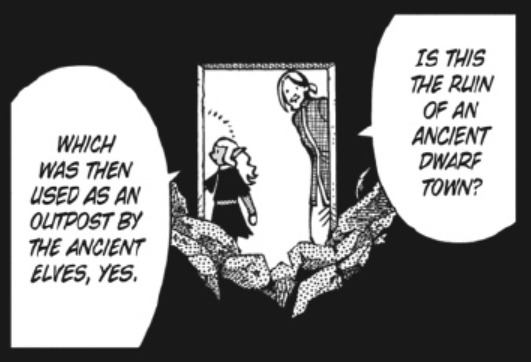
Regardless, at least one of these conflicts seems to have taken place after the golden kingdom was sealed - so, within the last 1000 years.
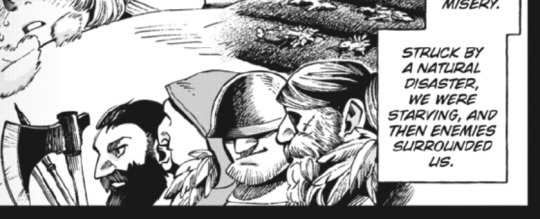
Though, this could refer to a different, more localised conflict between the Golden Kingdom and their dwarven neighbours.
The order of events is that the Golden Kingdom was sealed (1000 years ago or so) > Dwarves took over > Elves stole the land from the Dwarves ("long ago" by the Island Lord, a tallman's, standards) > Elves gave the land to a local lord, who was either an ancestor of the Island Lord, or the Island Lord himself. The Island Lord is himself a descendant of the lord who poisoned Delgal's father, as is noted in the World Guide. However, it isn't impossible for there to be large gaps of time between these events, which could put the elf / dwarf wars at a more recent date.
The fact we know that the elves stole the land from the dwarves, and then granted it to a political actor who was relevant during the events of the Golden Kingdom flashbacks we see suggests to me that the events were roughly contemporaneous. If they were, that puts at least one of these conflicts at roughly 1000 years ago.
So, the elf/dwarf & gnome conflict is "long ago" by short-lived standards, but would be considered "modern" by the long-lived races, if you ask me. At least, the equivalent of the World Wars for us - recent history, even if we weren't alive.
I'm guessing the "Elf King" from the below panel in fact was a word that's more gender-neutral in Japanese, since the "Western Elves" definitely have a queen.
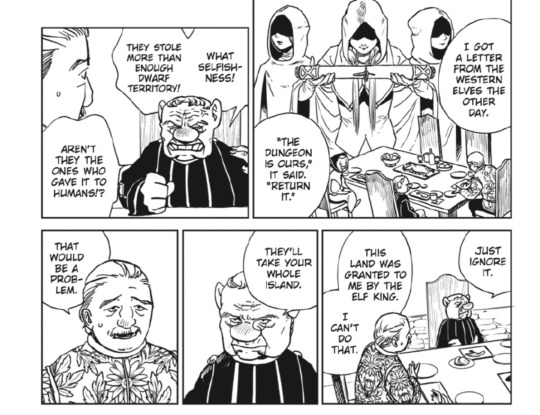
Language
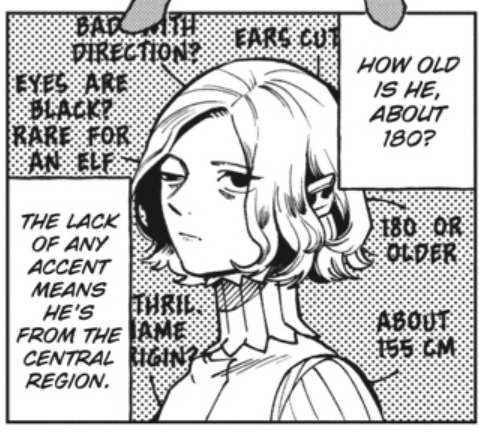
When Kabru says the "Central region" I expect he means the region where the NCC and SCC is.
The fact that he observes that the lack of any accent means he's from the Central Region is really interesting. It could mean two things;
either they switched to speaking in the language spoken on those continents, which Kabru would naturally know, having grown up there. It's 100 percent possible, but I think this would be noted in the story.
or, the language that gets called "the common tongue", the one that all our principle characters speak for most of the story, originated from the elves in the Central Continent. Or at least it's the same one that the elves use, and their political influence is great enough that their accent gets to be considered not an accent at all. The fact they were "granting" land in this area to tall-man lords suggests a large enough historical influence in the area that this is quite plausible to me.
Mithrun absolutely does have an accent - nobody speaks without an accent. His accent is just politically and socioculturally normalised to the point of being considered the "default/proper" way to speak - like received pronounciation in English.
The common tongue isn't ubiquitous everywhere - not just Kuro, but Kiki and Kaka are also noted to be studying the common tongue. The Tansus were born on the Eastern Continent, so probably gnome communities there speak their own language - Kiki and Kaka grew up primarily surrounded by gnomes after all.
It's also quite likely that Kabru, specifically, because of where he grew up, would consider Mithrun's way of talking to be the default "not an accent" accent. His adoptive mother surely has the same upper-class NCC accent. I expect that other characters might experience it as more "marked".
This isn't a world where everyone speaks the same language everywhere; the common tongue is called that, but there are many different languages. Kabru and Chilchuck are two characters who are adept with many of them - Kabru speaks the language of the kobold, and probably lots more. Chilchuck works as an interpreter as part of his union stuff - I can tell you from experience that that's a hugely valuable skillset in that context, as many of the people who most need union representation are people who don't speak the dominant language, or at least not fluently.
If you got all the way to the end of this post.... thank you for reading, I love you. Check out my other World Map Notes under that tag on my blog; I've made a few so far and there will almost certainly be more. Next I'm thinking the dwarven nations...? But I could be persuaded if someone had a preference.
Also, anyone got any speculation on what, exactly, is the previous time that Heimeya ate a person/monster/chimera that this panel implies:

We really don't have anything to go on whatsoever, but I think it's a fun tidbit.
#og post#dungeon meshi manga spoilers#dungeon meshi meta#dunmeshi#dungeon meshi analysis#delicious in dungeon spoilers#dunmeshi spoilers#delicious in dungeon#dunmeshi meta#the canaries#milsiril#mithrun#kabru of utaya#i feel sooooooo sane to have made this. but it has some super interesting details imo#colour coding only on the TLDR just cause I dont want ppl to take my theories as fact#character info I drop without a panel comes from the world bible#world map notes
372 notes
·
View notes
Text
Half Foot Prey Animal Theory Part 2
Since y'all really like my last theory (thanks for over 1,000 notes btw lol), have another one.


I think we've all seen that Izutsumi prefers to sleep with Chilchuck because he's very warm. A cat's body temperature is usually around 100 F, so it would make sense for her to keep herself warm with the warmest member. In the last panel, we can see that Chilchuck is uncomfortable warm from Izutsumi cuddling him, but why is that?
Well, smaller animals generally produce and expel more body heat than bigger animals. Most rodents like rats (99.85 F), rabbits (100-105 F), and squirrels (99-101 F) generally have a body temperature that's hotter than humans. All of these rodents are prey animals.

To go a long with that rodent comparison, I'd like to compare Chilchuck's ears to rodent ears. Chilchuck's ears are about 1/3 the size of his head, which is quite large. But the reasoning for his big ears (besides his good hearing) could be to release heat. Plenty of rodents and desert animals usually have big ears to release heat quicker so they can stay cool.
So why did the half foots evolve like rodents?

#dungeon meshi theory#dungeon meshi spoilers#dungeon meshi#delicious in dungeon#dunmeshi#chilchuk dungeon meshi#chilchuck#chilchuk tims#chilchuck tims#chucklefuck#prey animal#rodent#half foot biology#half foot#izutsumi#izutsumi dungeon meshi#izutsumi dunmeshi#falin dungeon meshi#dungeon meshi fanart#laios dungeon meshi#laios fanart#delicious in dungeon laios#laios chimera#dunmeshi laios#laios#laios touden#half foot marcille#falin#dunmeshi falin#chimera falin
401 notes
·
View notes
Text


Just saying 🙌
#Just a theory#Can’t change my mind#dungeon meshi#delicious in dungeon#dunmeshi#izutsumi#izutsumi delicious in dungeon#izutsumi dungeon meshi#asexual#ace#aromantic#aroace
235 notes
·
View notes
Text
How to Calculate the Comparative Ages of the Dungeon Meshi Races
(EDIT: I've made a follow-up post to this one here that has more evidence showing how the age ratios work.)
I've seen this topic come up again and again in various fandom spaces, so I figured why not make a post about it!
First thing's first: There is a little bit of inconsistency between the manga itself and the world guide, so obviously take all of the following information with a grain of salt.
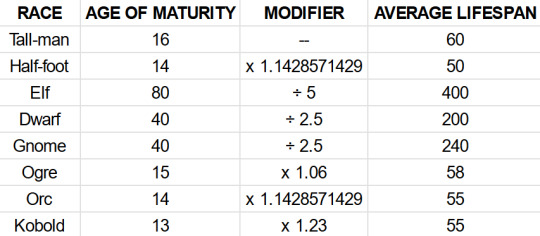
(The average lifespan number doesn't really impact this in any way, I just wanted to include the information. Also I fucked up this chart originally and had the division and multiplication symbols swapped because I'm an idiot.)
The way you get these numbers is you take the other ages, and either divide them by 16 (our baseline for adulthood), or divide 16 by the smaller number.
Examples:
16 ÷ 1.1428571429 = 13.9~ (Rounded up, that's 14)
80 ÷ 5 = 16
So using this, Chilchuck, a half-foot that is 29 years old is roughly equivalent to a tall-man that is 33 years old. He had his first child at 13 btw.
Senshi, a dwarf that is 112, is the equivalent of a tall-man 45 year old.
Namari, a dwarf that is 61, is the equivalent of a 24/25 year old tall-man.
Kuro, an 18 year old kobold, is the equivalent of a 22 year old tall-man.
Mithrun, an elf that's 185, is the equivalent of a 37 year old tall-man.
Pattadol, an elf that's 82, is roughly 16/17, so she is an adult at her first job!
Go forth and enjoy!
#dungeon meshi#delicious in dungeon#chilchuck#mithrun#senshi of izganda#namari#pattadol#my stuff#theories
2K notes
·
View notes
Text

someone's probably already made this joke but
our local children's hospital recently redecorated.
279 notes
·
View notes